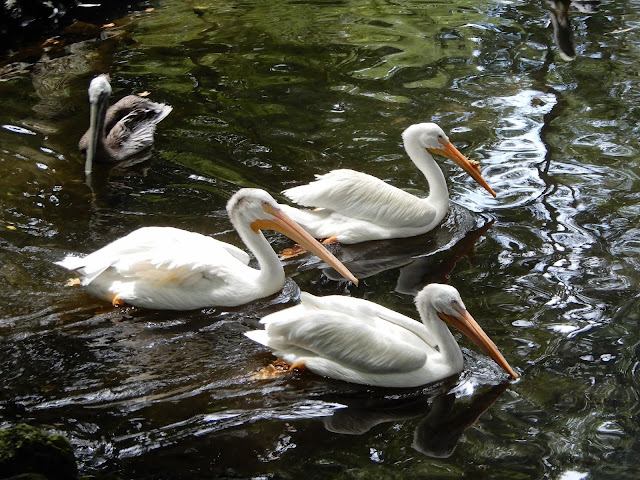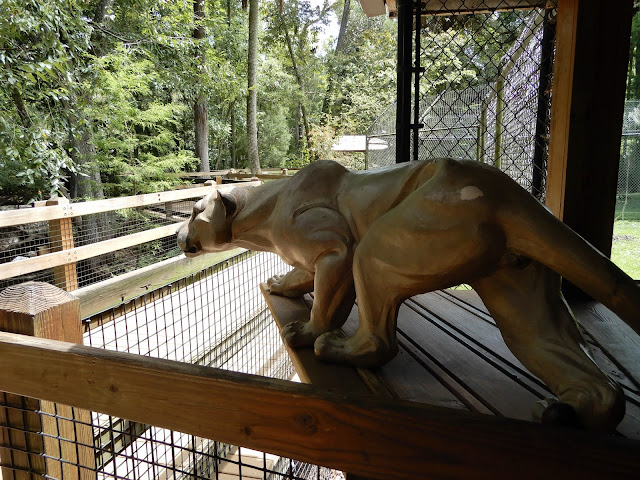On Saturday, Ron and I took a spur-of-the-moment drive to the Homosassa Springs Wildlife State Park. Our last road trip seemed like a lifetime ago, and we needed to go SOMEWHERE. We’ve been fortunate enough to take our boat out most weekends, but Saturday was too hot even for boating. To highlight just how much of a rut we were in, when we pulled out of the driveway, my phone notified me that it was a 17-minute ride to the boat marina. Sometimes, I think smart phones are getting just a little bit too smart. :-)
Even though we have been to Homosassa Springs many times to see the manatees, we had never visited the wildlife park before. The property was originally a tourist attraction and training center for exotic animals, but to protect the environmentally sensitive area, Citrus County purchased it in 1984, and it is now part of the Florida State Parks system. When the state took ownership, the focus changed from exotic animals to native Florida wildlife. The park provides a natural setting for native birds, Key deer, alligators, black bears, otters and bobcats who for various reasons would be unable to survive in the wild. One notable non-native resident is Lu, a 60-year-old hippopotamus who came to the park in 1964 from the San Diego Zoo. When the state was looking for new homes for the exotic animals, Governor Lawton Chiles received hundreds of letters, asking him to allow Lu to live out the rest of his life at the park. It seems fitting that Lu became a Florida retiree.
Due to the coronavirus, parts of the park were closed and the educational programs were suspended, but we were able to watch the staff feed the animals. Apparently, Lu was not a Hungry, Hungry Hippo when we were there. He was sleeping in the water with just his back sticking out, looking like the world’s biggest turtle. :-) When the staff brought out a big pile of hay and vegetables, he opened his eyes, wiggled his ears and went back to sleep. The birds were much more excited about their food. I love Florida’s birds, so I especially enjoyed seeing so many different species – sandhill and whooping cranes, herons, flamingos, pelicans, owls and even an eagle.
 |
| Lu, an honorary Floridian |
The Homosassa Springs Wildlife Park is probably best known for its manatee rehabilitation center. The park works with the Florida Fish and Wildlife Conservation Commission to treat injured or sick manatees until they can be released. It is also currently caring for two permanent resident manatees – Ariel and Betsy. From the observation deck, we watched Ariel and Betsy swimming slowly around the springs and chowing down on heads of romaine lettuce. The springs were spectacular, with water so clear we could see schools of sheepshead and mullet. The underwater portion of the observation deck was closed because of the pandemic restrictions, but there was a monitor showing underwater footage. The park even has an online webcam where you can watch the manatees from home. (Click here for the webcam.)
Although we didn’t get to experience everything that the park usually has to offer, I was very glad we made the trip. It was nice to get out of the house and see something new, and keeping a social distance was easy on the outdoor pathways. The natural shade of the park even made the 95-degree heat bearable. Homosassa Springs isn’t far away but it always feels like a different time and place to me – a little piece of Old Florida. We will definitely visit again when things return to normal.
 |
| Ariel and Betsy, waiting for feeding time |
 |
| webcam screenshot |
Travel tips: Homosassa Springs Wildlife State Park is open 365 days a year from 9 AM to 5:30 PM (virus permitting). Visit the Florida State Parks website for ticket prices and any current restrictions: https://www.floridastateparks.org/parks-and-trails/ellie-schiller-homosassa-springs-wildlife-state-park. Because we decided on the trip at the last minute, we didn’t get to the park until almost mid-day. I would suggest arriving earlier because animals tend to be more active in the morning before it gets too hot. Manatee feeding take place several times a day so there is plenty of opportunity to see the animals up close.















No comments:
Post a Comment